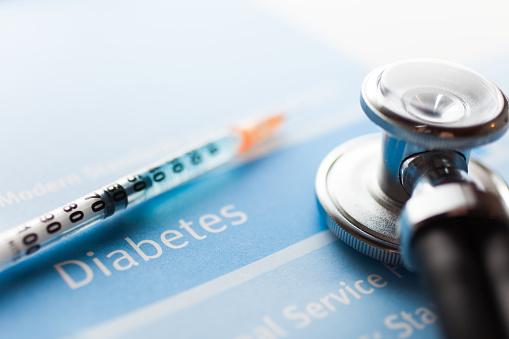Abstract
Diabetes mellitus (DM) is one of the chronic noncommunicable diseases with the greatest impact on public health and its growing prevalence in developing countries such as Brazil, associated with lifestyle and genetic predisposition, has led to the calculation of the risk of disease development become a starting point for its prevention. It is classified into: type 1 (DM1), type 2 (DM2), other types and gestational diabetes and is a disease that requires early diagnosis and adherence to treatment in order to avoid possible chronic complications such as: retinopathy, nephropathy, peripheral neuropathy, autonomic neuropathy and heart disease. Social isolation caused by the coronavirus pandemic has changed the population's lifestyle, prevailing a more sedentary behavior and a less healthy diet. These factors, added to the individual's family history, favor the development of type 2 diabetes mellitus in the future. This study aimed to calculate the percentage of risk of developing type 2 diabetes during the coronavirus pandemic, according to the indicators adopted in the FINDRISC methodology (Finish Diabetes Risk Score). The project was developed through an online questionnaire, containing objective questions, applied to two 275 volunteers of both sexes, divided into two age groups and obtained 47 men (33.57%) and 46 women (35.11 %) at low risk, while 4 men (2.86%) and 3 women (2.29%) were at very high
risk. Through this study, it was possible to conclude that the risk of developing type 2 diabetes mellitus is associated with extrinsic (lifestyle) and intrinsic (family history) factors.
References
BASTOS, M. N. et al. Alimentação de Diabéticos e Hipertensos: desafios e recomendações. REVISE - Revista Integrativa em Inovações Tecnológicas nas Ciências da Saúde, [S. l.], v. 4, n. 00, 2021. DOI: http://10.46635/revise.v4i00.1851. Disponível em: https://www3.ufrb.edu.br/seer/index.php/revise/article/view/1851. Acesso em: 23 abr. 2021.
BEULENS, J.W.J. et al. Alcohol Consumption and Type 2 Diabetes: influence of genetic variation in alcohol dehydrogenase. Diabetes Journals, [S. l.], v. 56, n. 00, p. 2388-2394, set. 2007. Disponível em: https://diabetes.diabetesjournals.org/content/diabetes/56/9/2388.full.pdf. Acesso em: 30 ago. 2021.
BHUTANI, S.; COOPER, J.A. COVID‐19 related home confinement in adults: weight gain risks and opportunities. Obesity, 2020. Disponível em: https://onlinelibrary.wiley.com/doi/10.1002/oby.22904. Acesso em: 04 dez. 2020.
BRASIL, Ministério da Saúde. 26/6 – Dia Nacional do Diabetes. Disponível em: https://bvsms.saude.gov.br/26-6-dia-nacional-dodiabetes-4/. Acesso em: 30 ago. 2021.
BRUTSAERT, E. F. Diabetes melito (DM). Manual MSD- Versão para profissionais de saúde. 2019. Disponível em: https://www.msdmanuals.com/pt/profissional/dist%C3%BArbios-end%C3%B3crinos-e-metab%C3%B3licos/diabetes-melito-e-dist%C3%BArbios-do-metabolismo-de-carboidratos/diabetes-melito-dm#v29299021_pt. Acesso em: 03 dez. 2020.
CHACRA, A. Diabetes é mais comum nas mulheres do que nos homens. 2017. Disponível em: https://hospitalsiriolibanes.org.br/suasaude/Paginas/diabetes-mais-comum-nas-mulheres-que-nos-homens.aspx. Acesso em: 24 abr. 2021.
COLDITZ, G. A. et al. Weight gain as a risk factor for clinical diabetes mellitus in women. Annals of internal medicine, [S.l.], v. 122, n. 7, p. 481-486, 1995. Disponível em: https://www.researchgate.net/profile/Graham_Colditz/publication/272952741_Weight_Gain_as_a_Risk_Factor_for_Clinical_Diabetes_Mellitus_in_Women/links/5754260608ae6807fb0405fc.pdp. Acesso em 27 abr. 2021.
DANTAS, R. et al. Utilização do FINDRISC no Rastreio da Diabetes em Utentes Assintomáticos. Revista Portuguesa de Endocrinologia, Diabetes e Metabolismo, [S. l], v. 12, n. 1, p. 45-51, 2017. Disponível em: https://bit.ly/2AY7nk8. Acesso em: 30 ago. 2021.
DEUS, K. J.; CONCEIÇÃO, R.S. Diabetes mellitus tipo 2 a relação genética-nutrientes. Revista Nutrire: Sociedade Brasileira de Alimentação e Nutrição, São Paulo, v. 37, n. 2, p. 199-214, ago. 2012. DOI: http://dx.doi.org/10.4322/nutrire.2012.016. Disponível em: http://sban.cloudpainel.com.br/files/revistas_publicacoes/365.pdf. Acesso em: 24 abr. 2021.
DURÃES, S. A. et al. Implicações da pandemia da covid-19 nos hábitos alimentares. Revista Unimontes Científica, [S.l.], v. 22, n. 2, p. 1-20, jan. 202. DOI: http://dx.doi.org/10.46551/ruc.v22n2a09. Disponível em: https://www.periodicos.unimontes.br/index.php/unicientifica/article/view/3333. Acesso em: 22 abr. 2021.
FERREIRA, M. J et al. Physically active routine during COVID-19 pandemic: do not fail to comply with the recommendations for cardiovascular health. Motriz: Revista de Educação Física, [S. l.], v. 27, p. 1-3, 2021. DOI: http://dx.doi.org/10.1590/s1980-657420210000212. Disponível em: https://www.scielo.br/j/motriz/a/qr4mMjXXsWgjy6mhp49dFRf/?format=pdf&lang=en. Acesso em: 30 ago. 2021.
GOMES, R. et al. Por que os homens buscam menos os serviços de saúde do que as mulheres? As explicações de homens com baixa escolaridade e homens com ensino superior. Cadernos de Saúde Pública, Rio de Janeiro, v. 23, n. 3, p. 565-574, mar. 2007. Disponível em: https://www.scielosp.org/article/csp/2007.v23n3/565-574/pt/. Acesso em: 24 abr. 2021.
LANUEZ, M. V. et al. Correlation between two physical activity programs in the gait of sedentary elderly subjects. Einstein (São Paulo), [S. l.], v. 8, n. 3, p. 281-284, set. 2010. DOI: http://dx.doi.org/10.1590/s1679-45082010ao1585. Disponível em: https://www.scielo.br/j/eins/a/x3j457mHpxTBQZ4PsQW4wbh/?lang=en. Acesso em: 30 ago. 2021.
LIMA, J. G. R. de et al. Effects of the COVID-19 pandemic on the global health of women aged 50 to 70 years. Experimental Gerontology, [S. l.], v. 150, p. 111349, jul. 2021. DOI: http://dx.doi.org/10.1016/j.exger.2021.111349. Disponível em: https://www.ncbi.nlm.nih.gov/pmc/articles/PMC8058051/pdf/main.pdf. Acesso em: 30 ago. 2021.
NORDSTRÖM, A. et al. Higher Prevalence of Type 2 Diabetes in Men Than in Women Is Associated With Differences in Visceral Fat Mass.The Journal Of Clinical Endocrinology & Metabolism, [S. l.], v. 101, n. 10, p. 3740-3746, out. 2016. DOI: http://dx.doi.org/10.1210/jc.2016-1915. Disponível em: https://academic.oup.com/jcem/article/101/10/3740/2764924. Acesso em: 30 ago. 2021.
OLIVEIRA, T. C, et al. (In)Segurança alimentar no contexto da pandemia por SARS-CoV-2. Cadernos de Saúde Pública, [S.l.], v. 36, n. 4, p. 1-6, abr. 2020. DOI: http://dx.doi.org/10.1590/0102-311x00055220. Disponível em: https://www.scielosp.org/article/csp/2020.v36n4/e00055220/en/#. Acesso em: 23 abr. 2021.
SOCIEDADE BRASILEIRA DE DIABETES. Diretrizes da Sociedade Brasileira de Diabetes: 2019-2020. São Paulo: Clannad; 2019. Disponível em: https://www.diabetes.org.br/profissionais/images/DIRETRIZES-COMPLETA-2019-2020.pdf. Acesso em: 05 jan. 2020.
SPOHR, M. A. Exercício físico e promoção da saúde na educação física escolar: cuidados com a diabetes mellitus tipo 2 e os marcadores sociais. 2020. Trabalho de Conclusão de Curso (Graduação em Educação Física) – Departamento de Humanidade e Educação, Universidade do Noroeste do Estado do Rio Grande do Sul, Santa Rosa, 2020. Disponível em: https://bibliodigital.unijui.edu.br:8443/xmlui/bitstream/handle/123456789/7014/MATEUS%20ARTUR%20SPOHR.pdf?sequence=1&isAllowed=y. Acesso em: 30 jul. 2021.
WORLD HEALTH ORGANIZATION. Diabetes. 2021. Disponível em: https://www.who.int/newsroom/fact-sheets/detail/diabetes. Acesso em: 30 ago. 2021.

This work is licensed under a Creative Commons Attribution-NonCommercial 4.0 International License.
Copyright (c) 2021 Érica Grassi de Lima; Renan Cardoso Tiago; Ismar Rodrigues

